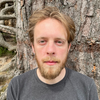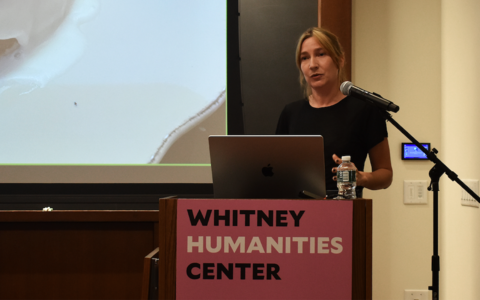Sheila Heti on Process
Sheila Heti, author of How Should a Person Be? and Pure Colour, joined the Whitney Humanities Center for a semester as our Fall 2022 Franke Visiting Fellow. The Franke Visiting Fellows Program allows the WHC to host one fellow each year for a residency that offers the time to nurture creative processes and provides opportunities for informal collaboration across the University.
Sheila spent much of her time with us thinking and talking about processes, individual, collaborative, speculative, and digital. Her fellowship culminated in a public lecture titled “What Is a Process?” I spoke with Sheila about this question, the chemistry or magic at work in successful collaborations, and her experience collaborating across domains at Yale.
NLP: What are you up to here in New Haven?
SH: Well, I’m living in Niantic. I’m here, mostly taking my dog on walks by the sea, which is really nice—I’ve always wanted to live in a house by the sea. And I’m enjoying going to these lunches once a week that the Whitney Humanities Center organizes, where people from different disciplines present their work. Apart from that, I’ve been teaching a class with Noreen Khawaja called “Fate and Chance in Art and Experience.” We’ve read all sorts of things, like Simone Weil, Kierkegaard, the I-Ching…
NLP: What is your sense of what readers and writers are looking for when they want to know about a creative process?
SH: I think a work of art that works is kind of a magic trick. Or it is magic, and people want to know how it comes to be. The artist wants to know too, so part of the pleasure of giving a craft or process talk is trying to track for yourself how it happened. I try to be as honest as possible. If anything, I like to underplay the difficulty of making a book because that’s talked about a lot, and what isn’t talked about a lot is the fun of not knowing where you are, or where you’re going. All these talks are kind of a lie, because they try to make retrospective sense of what was just sort of grasping and moving forward and backwards and sideways, and not really knowing if you’re going to end up with something. The process is so much more troubling than it sounds when you’re talking about something that’s already done. I come from a background in theater, and I think the most interesting place to be is not in the audience, but backstage. I like artworks that reveal the backstage.
NLP: For a lot of people, theater might also seem to be a more obviously collaborative, creative space than writing is. But what do we mean when we talk about collaboration?
SH: I mean, as a writer, you are taught that writing a book is a fundamentally non-collaborative process, that it must all just come out of your mind. Anything else is suspect or cheating—or makes it less yours, less original, or less what a book is supposed to be, which is something like the pure essence of your individual human soul. Very few people work in that sort of isolation. Most writers I know, myself included, share drafts quite frequently with friends and other writers. And you sort of need to, because you don’t really know what you’ve made from the outside unless you have feedback.
I just like conversation, so I want not just sharing my drafts, but conversation to be part of the making—I want my interactions with other people to be part of the material. Not only do I not want to write entirely alone, I also don’t want to be entirely alone when I’m writing. I don’t think my brain is the best brain, and I don’t even think my brain is necessarily the best brain to make my own art. Other people know things I don’t.
A good model of collaboration is open-source software, and the idea that having many people look at something is a way of catching problems earlier, or catching problems that you yourself wouldn’t catch. I guess that’s the model that I like.
NLP: I’m curious what domains you’re most interested in right now beyond your own. Which I guess also leads to the question: What do you think of as “your domain”?
SH: I started taking CS 50 [Introduction to Computer Science] when I got to Yale. Computer science is a domain that I’m interested in, or the domain of programming and in some sense engineering. I’ve been reading this book about software engineering at Google. Those domains are quite different from mine—and then also aren’t. If you look at the principles of what makes a well-written computer program, they’re simplicity, and you know, a kind of directness—it has to work. I just think of programs as writing for computers and this as writing for humans. I mean, it’s a language, there’s so much about coding that kind of rubs up against writing for humans. There’s a lot of thread-finding and pattern-making, you know?
NLP: Do you have an interesting example of the most surprising, unlikely, or bizarrely successful artistic collaboration that you find yourself thinking about again and again?
SH: I mean, the Beatles! Bizarrely successful—like you just can’t even understand how they wrote so many great songs in such a short period of time. Did you see the Beatles documentary? The recent Peter Jackson-directed one? It’s actually one of the things we were teaching in class. Just the degree to which it’s play and improvisation—and I mean, there’s obviously tension between them, but they’re still kind of goofing around and this beauty comes out of it with seemingly very little effort. So that’s just like the magic of those four people together.
I think that collaboration’s like chemistry. You collaborate with people that you have a particular chemistry with, that creates this new mind that’s not yours and not theirs. I think you probably can’t collaborate with most people. Talking about fate and chance, I think what creates that new mind—where it feels like the artwork comes out of—is fated, you know, or it’s chemistry, or it’s something kind of inexplicable. With How Should a Person Be, it felt like it came out of that mind that Margaux [Williamson] and I had created together, not knowing that [the novel] was where things were going—and same with her paintings at the time. Teaching this class with Noreen [Khawaja] feels like that. The class feels like a collaboration, our teaching it together and the ideas that we’re coming up with, and talking—really one of the best parts of the class is preparing, talking about it, just the conversation that’s happening sort of outside the classroom.
 Nathaniel LaCelle-Peterson is a graduate student in Comparative Literature and Film and Media Studies broadly interested in ways of thinking about material and form from the nineteenth century to the present. He is also a Whitney Humanities Center Graduate Fellow in the Environmental Humanities.
Nathaniel LaCelle-Peterson is a graduate student in Comparative Literature and Film and Media Studies broadly interested in ways of thinking about material and form from the nineteenth century to the present. He is also a Whitney Humanities Center Graduate Fellow in the Environmental Humanities.

